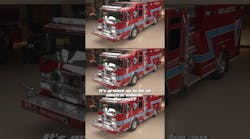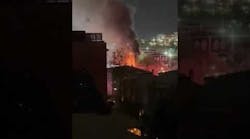Well, I can tell you what firefighters are not thinking. They are not thinking about the dangers. They are not saying to themselves, "Boy I hope we get out of here alive". They are not worrying about the building falling down.
What engine company firefighters are thinking is how many lengths of hose they need to reach the fire floor. Truck firefighters are thinking about how to get to the roof to cut a ventilation hole. Other firefighters are trying to decide where to search for people based on the time of day and occupancy.
What people are really asking is, "How do you get your people to follow you into such dangerous situations?" The answer in a word is Leadership! One of the most important yet often ignored traits of fire service officers.
From a leadership perspective there are three very important leadership principles at work while your firefighters are running into a burning building.
First, the firefighters arriving at structural fires are not only allowed but expected to size-up the situation, select a method of attack and go to work. Very often no orders are given, no specific tactics need to be requested, but instead immediate actions are initiated. This is a successful process because we allow our firefighters and officers to use their skills and talents, developed and refined through effective training and years of fireground experience. I like to describe this principle with the term, "You can't beat out a fire with a hook".
The origin of this term is the result of the rivalry between engine and truck firefighters. Engine firefighters, with no tools except a charged hose line, literally crawl into the burning room and extinguish the fire. Truck firefighters force doors, ventilate, search and rescue people from the burning building. Along with their truck duties these firefighters receive accolades and recognition for their heroic work, while the engine firefighters usually end up with burned knees. Besides the satisfaction of actually putting out the fire, the engine firefighter has little to show for their hard and dangerous work except the knowledge that the truck can do an awful lot but they can't beat out the fire with a hook!
This is more than just a way of saying you should value your people for what they can do for you. It's more about getting the most out of your people. An accountant auditing the FDNY would categorize our engines, trucks, tools and firehouses as assets. Our expenses would include fuel, electricity, tires and our largest expense, staffing, our people. Unfortunately many organizations see their people as expenses, not assets. Do you?
The essence of this first leadership principle lies in trusting your people and allowing them to do what they're good at, in a way that best suits them. Like how the FDNY handles building fires, allowing our people to get right to work, without micromanaging. We focus on results over methods. There are usually several ways to initiate many of our tactics. Our officers and firefighters are trained and familiar with these options and can quickly size-up the situation and begin operations without direct and specific instructions.
Another way of helping your people to do what they're best at is to help them move into positions better suited for their skills. Firefighters that show an affinity for tools and technical equipment are often encouraged to move from engines to truck or rescue companies. Allowing and encouraging this type of movement not only allows the individual firefighter to apply their skills and feel more fulfilled, but it gets the most out of this asset for the department. Firefighters are dedicated because their leaders trust them, allowing them to "own" their jobs. This leads to innovation and results in firefighters that are "into the job".
So what does this mean for the leaders of your organization or fire department? Spend time with your people, observe them, find out what they're good at and help them move into or stay in positions where they can maximize their talents and your interests. Don't view your people as interchangeable or think that because someone was good at one thing they will be good at another. Be careful not to promote people into positions where they have more weaknesses than strengths. In other words don't waste your asets where they can't do you or your organization any good.
What I want you to take away from this idea is that people produce best when they are working to the fullest of their abilities, not necessarily where someone else thinks they fit in or where there is a perceived need. It's not about wearing jeans on Friday, but instead, having people who look forward to coming in on Friday to finish a project that they helped create and have a passion for.
The second leadership principle being played out at the scene of a fire is called "Following the Smoke". That's the chief gathering information and feedback from diverse sources in order to define the problem at hand. This principle reminds me of an incident I had during a night tour in battalion 18 in The Bronx. I responded with 2 engine and 2 trucks to a report of smoke in a restaurant at about 1am. There was a slight haze present yet it did not appear to be serious. It did however have the distinct odor of wood burning, which is often an indication of a fire burning somewhere within the walls or ceilings of a building. After about 15 minutes of investigation including making small examination holes in the ceiling and sending firefighters to the areas above, below, behind and adjacent to the restaurant, we were starting to run out of possibilities. Then a firefighter notified me that he could see smoke coming from a vent pipe of the building behind the restaurant. We moved our investigation into that building and discovered a fire in a room. We stretched a line and ventilated the building and after a short while returned to quarters. We had spent over 90 minutes at this alarm and we "followed the smoke" until the real problem was finally uncovered. This principle can be used at any fire or any other type of "problem" in any other industry.
"Following the Smoke" involves listening to others observations and insights. Being persistent in trying to uncover the real problem. Not settling for the easy or first solution to a problem and striving for a positive outcome Obviously the smoke in this story is just a kind of information. Leaders in any fire department or other organization can follow the smoke by making sure they are up-to-date on what's happening in their industry. This can be accomplished by talking to your front line people. I try to do that every tour I work in my Bronx battalion. I visit each of the six units and sit down with the firefighters and company officers and talk about what is happening. You would be surprised how often I an surprised to find out about a particular incident or activity that is the topic of discussion for that day or that firehouse. You also need to face unpleasant realities and address them. If something is going on that you are not pleased with or that you think should be handled in a different way, you need to address it by saying something. Let your people know what you think and point them in the direction that you want. Be thorough and rigorous when defining problems. If you don't get this right. You have no chance of coming up with the best solutions.
What is most important to remember about "following the smoke' is that the key to overcoming obstacles and solving problems lies in first defining the problems correctly. Whether it is where the fire is hiding at a building full of smoke or why your departments response times are climbing, you need to find the problem before you can find the solution.
The third leadership principle illustrated here is called "You've Got The Nozzle" which related to the leadership that is going on inside a burning building. The activities of captains, lieutenants and seniors firefighters. I can't order people to be leaders. It's not a quality that's available on demand and it doesn't happen by itself. What we do in the FDNY is;
First, we delegate to people in order to provide them with a controlled leadership experience. Company officers are often the first to arrive on the fire floor and will make the "call" concerning whether a hoseline is need or more units are required.
Next, we trust people to do their jobs and we even give them the freedom to make mistakes. Obviously we are talking about small mistakes that can be corrected and discussed, but still, a good leader cannot be developed unless they are given the opportunity to make decisions, both good and bad.
Third, we make sure that when mistakes are made, we use it as an opportunity to talk about the situation, and how to better handle it next time. A situation that illustrates this point occurred during the final minutes of an all-hands fire in the Bronx that I operated at. All of the units on the scene were busy and I needed a secondary search of an area in the fire building. Since no ladder company was available I asked the lieutenant of an engine company that was standing by if he could take his unit into the building and perform that search for me. He agreed and entered the building with his firefighters. Several minutes later, when they exited the building ands reported the result of the search I noticed that none of the firefighters was carrying a hand tool. Normally engine firefighters don't carry tools because they stretch and operate hoselines, but I hadn't noticed that they didn't take tools into the building with them. I almost let it slide figuring that the lieutenant jumped at the opportunity to get his men into the building and finished the search quickly. But I couldn't. I called him over to the side and explained that he should have told his men to take tools with them in case they needed to open up and area or force a door to complete the search. He agreed and said "thanks" for the tip and for letting him know what I expected.
Finally, mentoring is used to expose or future leaders to the real life activities of our current senior people. This experience is often the turning point in the leadership development process. It is highly effective because principles and strategies are finally observed in action, being performed by people whose experience and reputation lend credibility to the entire leadership theory of the organization. FDNY captains, before being promoted to battalion chief, attend a 6 week command course that culminated with a mentoring experience where they ride along with senior battalion chiefs in the 5 boroughs. They work in the battalion office, respond on alarms and operate at fires and emergencies with their mentor and take it all in before they are send out on their own after promotion.
Each of the three concepts I've discussed are individually valuable, but when combined with the others produce an impact even greater than the sum of their parts. These three leadership principles are not exclusive to firefighting, but when understood and practiced, will take leadership in your organization to new hights. By putting these three principles to work every day, you can inspire your people to follow you anywhere, even into a burning building.
Buy The Book: First In Last Out, Leadership Lessons From The New York Fire Department







